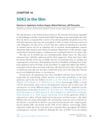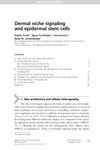Multi-scale modeling for cell fate specification during regeneration and development
January 2020
in “
eScholarship (California Digital Library)
”
TLDR Signaling factors and gene-driven cell adhesion are crucial for wound healing and embryo development.
The document discussed multi-scale modeling approaches to understand cell fate specification during tissue regeneration and early embryo development. For skin wound healing, a model was developed using the Subcellular Element Method (SEM) and partial differential equations (PDE) to study epidermis-dermis interactions, predicting that signaling factors are crucial for dermal stability and that wound-triggered signaling and re-epithelialization reduce wound size. It also found that fibrin clot density affects scar phenotype, with shallow wounds resulting in less scarring. For early embryo development, a data-informed model using SEM and stochastic differential equations (SDE) was created to study gene expression and spatial arrangement at the single-cell level. The model revealed that Epha4/Ephrinb2 gene-driven cell adhesion is vital for spatial organization, and a specific time window for fibroblast growth factor (FGF) regulation is crucial for successful cell fate changes.



